Hospital Ship
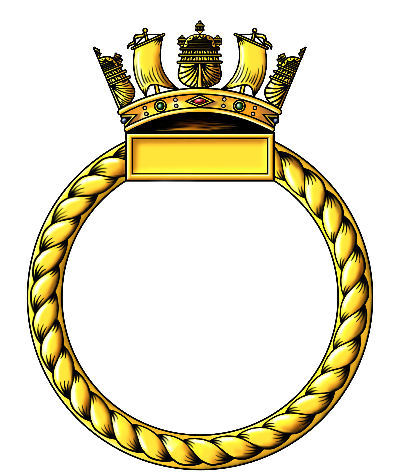
No badge issued for this vessel
Battle Honours
None
Specifications
Builder: NV Nederlandsche Scheepsbouw-Maatschappij , Amsterdam, North Holland, Netherlands
Displacement: 10,945 Gross tons
Length: 457.7 ft
Beam: 364.7 ft
Draught: 34 ft
Propulsion: Stork Hengelo 6 cylinder 2-stroke single acting diesel, single propeller, 6000 bhp
Speed: 15 Knots
Armament: None
Crew complement: Unknown
Commanding Officers
Captain H. de Jonge
Senior Medical Officer
Surg. Capt. J. M. F. Capbell, MB, CnB July 1942
Surg. Capt F. G. Hunt, MB, Bch November 44
Related items
None
Reminiscences
None
Gallery
None
H.M.H.S. TJITJALENGKA
Read aloud
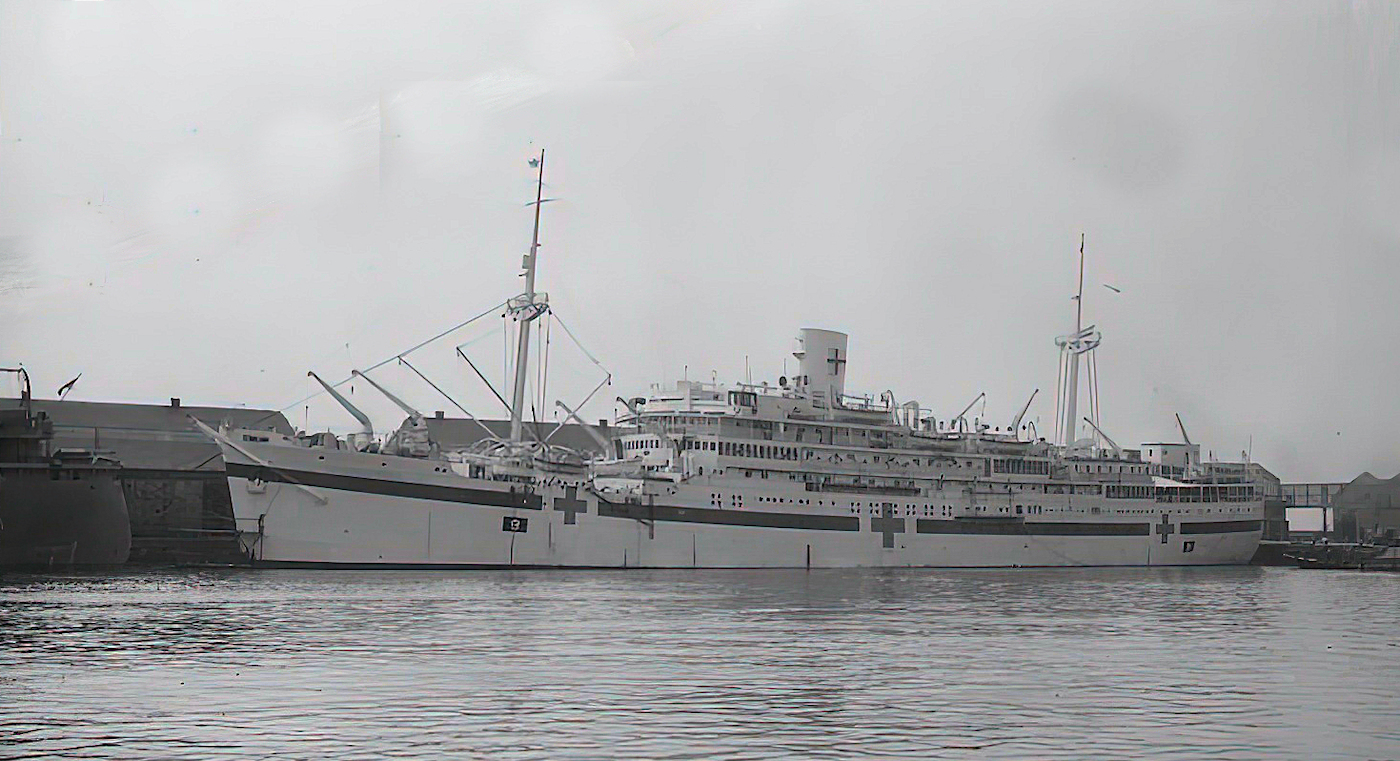
TJITJALENGKA on completion of her conversion into Hospital Ship No.9
Early history
The M.V. TJITJALENGKA was a 10,945 Gross Tonnage Passenger/cargo vessel ordered by the NV Java-China-Japan Line (JCJL), Batavia, Netherlands East Indies for service in the North Pacific. She was ordered from NV Nederlandsche Scheepsbouw-Maatschappij, Amsterdam, and laid down as yard number 271 .She was launched on August 16th 1938 by her sponsor Mrs. C. F. J. Quarles van Ufford, wife of one of the directors of the shipping company.
TJITJALENGKA was to be the new flagship for the JCJL: on completion of builders sea trials and fitting out she was delivered on April 29th 1939. Passenger accommodation consists of 64 first class berths, second class was split with 55 “A”' class berths and 100 “B” class berths and 1,800 deck passengers could be accommodated in the upper 'tween-decks.
Under the command of Captain H. de Jonge, former commander of the previous flagship the M.V. TJISADANE, she sailed on her maiden voyage to the Orient in mid-May, on arrival at Batavia she was to operate the express service from Java to Hong Kong, Amoy and Shanghai, with additional stops at Manila, Cebu, Makassar and Bali.
TJITJALENGKA operated this service until February 13th 1941 when all Dutch shipping the North Pacific was ordered to put into neutral ports as fears grew over the build-up of Japanese naval forces in the northern Pacific, TJITJALENGKA was on passage from Manilla to Hong Kong and was ordered to return to Manila to await further orders.
Requisitioned by the British
Her activities after receiving this order are unclear; some reports have her being requisitioned for use by the British Ministry of War Transport in September 1941 for use as a troopship, but in February 1942 she is recorded as still in Java when she acted as a temporary accommodation ship for the crew of USS MARBLEHEAD while urgent repairs were carried out in the port of Tjilatjap. She is next recorded as having crossed the pacific and transited the Panama Canal, departing Key West on May 24th in convoy KN.103, her ultimate destination being Liverpool. Shew arrive in Hampton Roads on May 29the and then on to Boston depart there on June 2nd bound for Halifax where she arrive on June 4th. Joining in convoy HX.193 se sailed from Halifax on June 7th, and arrived at Liverpool on June 19th 1942.
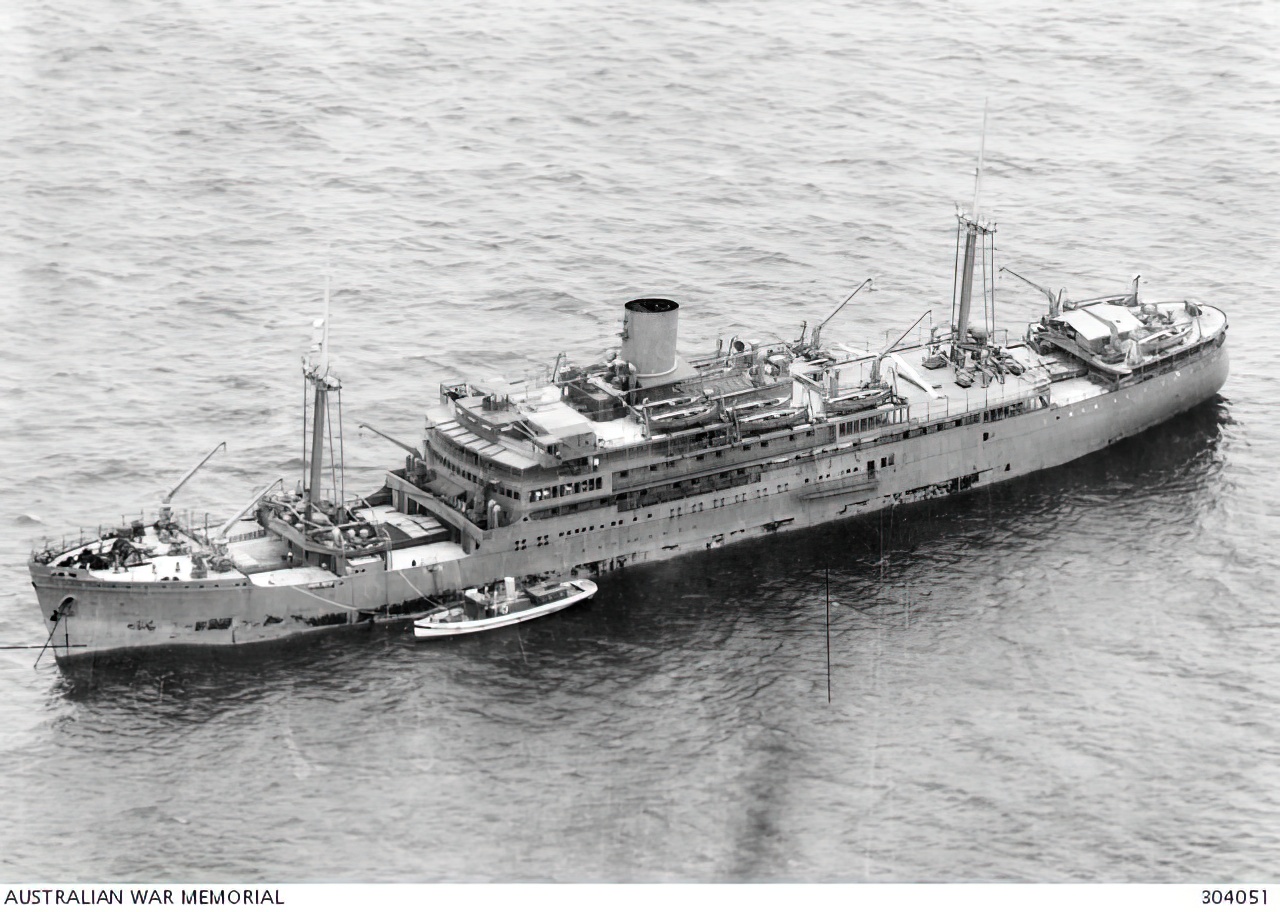
TJITJALENGKA c.1941 painted overall grey after being requisitioned
Conversion into a Hospital Ship
Upon arrival at Liverpool she entered a dockyard for conversion into a hospital ship with a capacity for 504 patients (with the possibility of expansion to 1,008). The work took two months to complete and she was commissioned on October 2nd 1942 as 'Hospital Ship No. 9'. She was now painted overall white with a green line round the hull with large red crosses painted amidships and on the funnel. At night she sailed with all her lights on illuminating the Red Crosses to identify her as a non-combatant and therefore protected by the Geneva Convention.
She remained under the command of her Dutch captain and ship's officers, Chinese and Indonesian merchant marine crew. British medical staff of 12 doctors, 12 sisters, 55 sick-bay attendants and other ratings manned the hospital, Surgeon Captain J. M. F. Capbell, MB, CnB, arrived on board as the principle medical officer on July 28th.
Hospital Ship No. 9'sailed for Belfast on October 4th after embarking Canadian casualties for passage to Halifax, Nova Scotia. After a brief stop in Belfast she arrived at Halifax on October 12th. She was to spend nearly a month in the cold climes of Nova Scotia; built for service in the tropics TJITJALENGKA had no heating. Having delivered her charges she departed Halifax empty on November 9th bound for Freetown, Sierra Leone, West Africa.
Duty as Base Hospital Ship: Freetown, and Mombasa
On her arrival at Freetown on November 20th 1942 TJITJALENGKA took up residence as the Base Hospital Ship. The RN depot already had a small single story hospital but his was not adequate for the medical needs of the units in the area in wartime.
She was relieved by another Hospital Ship in mid-February 1943 and after transferring her patients sailed on the 20th for Mombasa where she was to join the Eastern Fleet. On passage south she developed engine trouble and anchored in Saldanha Bay, Namibia on March 3rd where the ship’s engineers carried out repairs till getting underway again on the7th. She put into Cape Town on March 12th, called at Durban on the 16th before arriving at Mombasa on March 18th to take up the role of Base Hospital Ship. On 1st July 1943 TJITJALENGKA was reclassified as a Dutch Hospital Ship.
After six months in Mombasa she was reallocated for service at Trincomalee, Ceylon but before a taking up the new duty she was to undergo a short refit, fumigation and bottom clean which required dry-docking Durban. She sailed from Mombasa on September 18th, calling at Diego Suarez and arriv9ing at Durban on the 25th.
On completion of the dockyard work she sailed from Durban on October 21st bound for Bombay, arriving there on November 3rd. Here she was to embark a group of African soldiers who had contracted Tuberculosis; once the walking patients had embarked TJITJALENGKA sailed for Colombo on November 5th, arriving there on the 8th. On December 4th she sailed for Trincomalee arriving there on the 6th to take up her permeant station.
TJITJALENGKA remained at anchor in Trincomalee harbour until July 20th 1944 when she sailed for Colombo to embark patients for transport to Mombasa, sailing seven days later, arriving there on August 8th. She departed Mombasa for Durban on the 15th and arrived there on the22nd. Here she was again placed in dockyard hands for work including another fumigation.
Her dockyard repairs were completed on September 17th and TJITJALENGKA sailed for Colombo on the 19th; calling at Mauritius on the 25th and Addu Atoll on the 30th and arrived at Colombo on October 2nd. She sailed again on the 5th, arriving back at her berth at Trincomalee on October 7th. Surgeon Captain F. G. Hunt, MB, Bch arrived on board on November 21st 1944 to assume the post of Principle Medical Officer.
Reallocated for service with the British Pacific Fleet
Until now TJITJALENGKA’s hospital had been mostly operating as a static unit attached to a Naval Base, either to provide medical facilities or to enhance an existing hospital ashore. Her next tasking was to be very different, she would be receiving and treating casualties of combat when the British Pacific Fleet (BPF) began operations against the Japanese. She sailed for Colombo on February 26th 1945, arriving there on the 28th where preparations were now being made to store the ship for service in the Pacific. She sailed for Sydney on March 3rd. She entered Sydney harbour on March 21st.
After embarking more stores and personnel she departed from Sydney on April 4th bound for Manus were she arrived on the 13th. After fuelling she sailed for Leyte, the Philippines to join the support vessels of the Fleet Train (Task Force 112) of the BPF (Task Force 57).
TJITJALENGKA arrived at Leyte on April 19th where she joined HM Hospital Ship OXFORDSHIRE which had arrived on March 27th and the New Zealand Hospital Ship MAUNGANUI which arrived on April 14th. OXFORDSHIRE and MAUNGANUI were to operate as Auxiliary Naval Hospitals at Leyte, each ship being responsible for half the ships moored in the anchorage. Patients were discharged to their own ship or, if this had sailed, to a ship which acted as a pool depot. Some serious cases were transferred to ships returning to Australia. TJITJALENGKA was to spend the next three weeks anchored in San Pedro Bay before being called forward by the Commander, British Pacific Fleet (now designated Task Force 57.
he fleet had sailed from Ulithi Atoll on March 23rd 1945 for operations as part of the U.S. Fifth Fleet under Admiral Raymond Spruance U.S.N. They joined US Task Force 58 on the 26th to begin joint attacks on the islands of the Sakishima-Gunto group in support of preparations for US landings on Okinawa. There were 12 strike days planned against Japanese airfields on these Islands in phase one of operation ICEBERG. Because of the long distances involved between the operational area and the nearest forward base, all replenishment had to be done at sea; TF57 was operating a strike cycle of 2 days on station followed by 2-3 days of replenishment. There were three areas used for fuelling, each was a rectangular area which covered 5000 square miles of ocean east of Luzon, their code names were all called after insects; each area was 50 miles to the south and 100 miles west of' the following positions – 'COOTIE' 21° 52’ N 129° 24’ E; 'MIDGE' 19° 55’ N 129° 40’ E; and ‘MOSQUITO' 20° 17’ N 125° 22’ E. The nominated area could change from one replenishment period to the next. There were 12 strike days planned during this phase before the fleet was to return to Leyte for a longer replenish and repair period.
First casualties embarked at sea
Prior to her arrival on station all casualties ferried back from the forward area by Escort Aircraft Carriers (CVEs) of the Air Train on completion of their replenishment sorties and transferred to OXFORDSHIRE at the San Pedro Bay anchorage. The frequency of the Kamikaze attacks and the potential delays in evacuating the resulting casualties using only the replenishment CVEs [1] prompted the Commander, British Pacific Fleet to call TJITJALENGKA forward to operate in the vicinity of the replenishment area; she sailed from San Pedro Bay on May 10th to rendezvous with the Logistic Support Group in the vicinity of replenishment area ‘COOTIE’ on May 10th, on arrival in the afternoon of the14th she was ordered to be on station within 30 miles of a position 85 miles to the eastward of the normal dawn position of the Fleet in the fuelling area. TF 57 had just completed their ninth strike series and had withdrawn to refuel and take on stores. TJITJALENGKA was deliberately kept separate from the ships of the Logistic Support Group, this comprised of a tanker group and support vessels including aircraft replenishment carrier and naval escorts.
She had been called forward to accept Casualties fit to be evacuated, they were transferred to her by destroyers during the afternoon. This operation, transferring patients from ship to ship, was carried out underway by light jackstay transfer,, both ships moving at the same speed and on the same compass bearing, only 20 or 30 feet apart, and the patient was hauled aboard over the wire connecting the two ships. She received more sick and casualties on the 19th during the next replenishment period.
Prior to her arrival on station the replenishment escort carriers were tasked with casualty evacuation and had been called on three times to perform this role after the Fleet Carriers of TF 57 had been the targets of Kamikaze suicide planes; the first casualty evacuation was on April 5th when SLINGER embarked 16 injured men from INDEFATIGABLE which was hit by a single 500lb bomb on April 1st; the second was on May 6th when STRIKER (Flag 30ACS) embarked 35 casualties from FORMIDABLE which was seriously damaging on May 4th, and 20 casualties embarked in SPEAKER on the 1oth from FORMIDABLE and VICTORIOUS hit by Kamikazes on the 9th. Once all casualties had been transferred she sailed for Leyte at 19:15 where the casualties were transferred to HMHS OXFORDSHIRE.
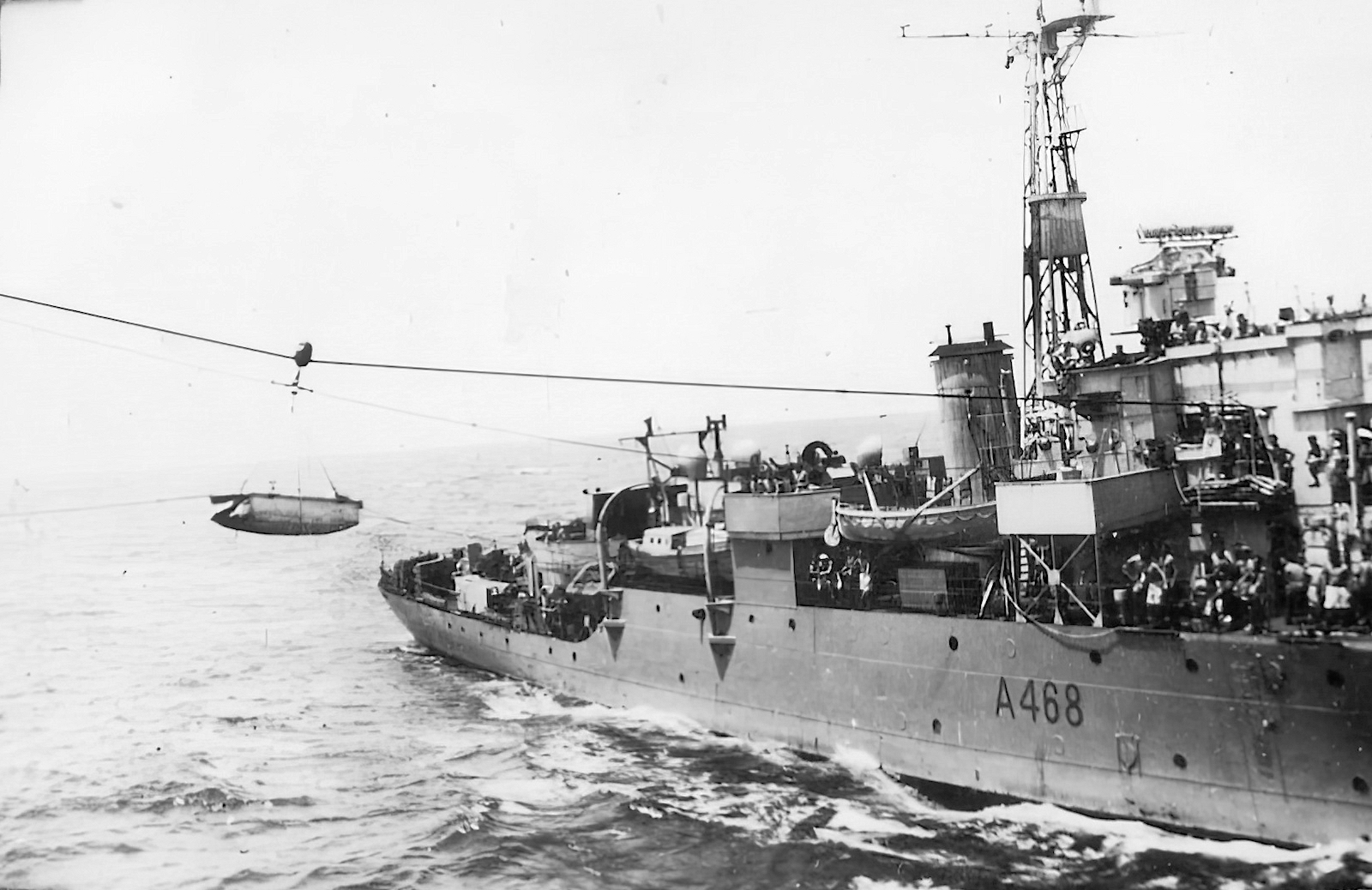
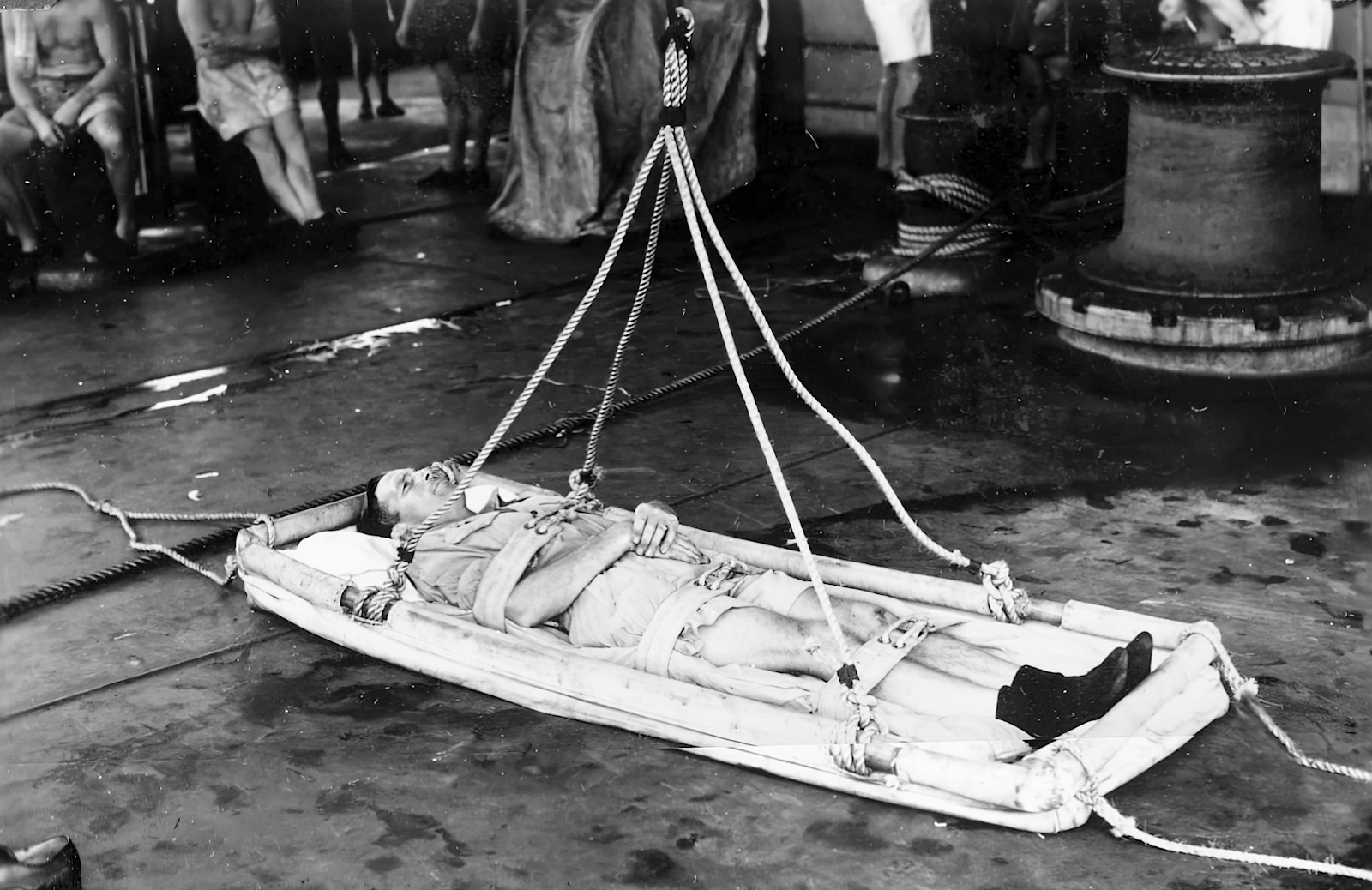
The process for transferring casualties from ship to ship by light jack stay transfer.
On the 25th TF 57 completed their final strike day of operation ICEBERG and set course for area COOTIE to top off ships with fuel as necessary for them to reach Manus. This last replenishment was completed on May 26th after which the Logistic Support Group (and TJITJALENGKA?) withdrew, arriving at Manus on May 31st. The main part of the BPF was to carry out major replenishment in Australia, however some ships, for whom there was no room at Australian ports or who were to take part in the strike at Truk (Operation INMATE remained at Manus. The Fleet Train now withdrew from Leyte returning to Manus, the last group left on May 25th.
It is unclear when TJITJALENGKA arrived at Manus but she is recorded as sailing on June 14th to return to Leyte on loan to the US 7th Fleet. On arrival she anchored off Tacloban, at the head of Leyte Gulf on June 19th and relieved the USSS REFUGE as the Base Hospital Ship on temporary detachment. A USN medical officer, a Hospital Corp officer and 2 Hospital Corpsmen were embarked for liaison duties. She relocated to Samar on July 10th and was released from detached duty on August 1st when she sailed to join the Logistic Support Group.
The BPF redesignated Task Force 37 for strikes against mainland Japan
The BPF now part of the US 3rd Fleet, and redesignated Task Force 37, had begun air operation against mainland Japan on July 17th and were operating approximately 250 miles east of Tokyo launching strikes against targets on the Island of Honshu. The replenishment areas were now much further north than for operation ICEBERG, area 'British TIZZY' (28°00'N, 138°55'E) approximately 460 miles south of Tokyo and ‘British DRINK’ (32° 25’ N 143° 30’ E) approximately 290miles south of Tokyo AND ‘British SWIM’ (34°10'N, 155°30'E) approximately 780 nautical miles east of Tokyo.
TJITJALENGKA escorted by CRANE appears to have been operating independently of the main Logistic Support Group, being reported as being off Japan in position 34° 08’ N, 146° 32’ E on August 5th and 35° 04’ N 151° 51’ E on the 8th further north than the replenishment area ‘British DRINK’.
Reorganisation of the BPF: Task Force 37 dissolved as plans change
On August 9th the second atomic bomb had been dropped on the Japanese city of Nagasaki, the first bomb had been dropped on Hiroshima on August 6th. Russia had declared war on Japan on August 8th and the focus of the US Third Fleet Commander altered to support Russian attacks: orders were to attack targets in northern Honshu on Hokkaido, the northern Island of Japan on August 10th, replenish on the 11th and conduct two more strike days on the 12th & 13th. This extension to the programme was problematic for the BPF which was to withdraw for Australia after the strike on August 10th.
The Logistic Support Group and Tankers were already executing the plans set out to prepare for the upcoming Operation OLYMPIC, the Invasion of Japan, so no Tanker support would be available. The US Logistic Group would not be able to contribute supply oil as it had done previously so the BPF would not be able to continue offensive operations as TF 37. The proposed a solution was a token force of 1 Battleship, 1 Fleet Carrier, 2 Cruisers and 10 Destroyers was to remain in the operational area for strikes against Japan with the US Third Fleet. At 12:00 on August 12th Task Force 37 was dissolved and the bulk of the BPF set course for Manus, and then on to Sydney; the remaining Force were now attached to US Task Force 38 and designated as Task Group 38.5.
On August 10th the Janise government made its first overture for a negotiated peace. President Truman issued instructions that no further atomic weapons were to be dropped on Japan without presidential orders but allowed military operations to continue until official word of a Japanese surrender was received. The US Third Fleet began making preparations for the evacuation of prisoners of war once the surrender was official.
TJITJALENGKA escorted by CRANE arrived in the vicinity of replenishment area ‘British DRINK ’on the 12th, and received orders to transfer all convalesce patients to their respective ships for passage to Australia. The Commander, BPF offered her services to the Commander 3rd Fleet for POW evacuation and she was ordered to join US Task Group 35 for this duty once ready. On August 16th TJITJALENGKA and CRANE refuelled from US tanker group TG 38.8, the token force that was now the BPF had also been fuelled by TG 38.8 on the 14th. Japan officially surrendered on August 15th.
Although hostilities had ended preparations for the accepting the formal surrender, the occupation and evacuation of prisoners, the various Task Forces and Task Groups off the coast were retasked with locating POW camps across Japan. By August 18th a British replenishment force had been assembled and was on station to meet the British force; on the19th TJITJALENGKA and CRANE were replenished at sea, a large part of this was provided by the escort carrier
SPEAKER. By this stage in operations the replenishment carriers had also been employed in carrying essential stores and provisions for issue to the fleet and for this run
SPEAKER carried 350 packages of stores, 237 oil hoses and 15 tons of potatoes all of which were issued by jackstay transfers at sea. Although offensive operations had ceased replenishment work was still necessary, a large part of the stores carried were destined for TJITJALENGKA, and 246 items of stores were transferred in a two and a half hour replenishment session.
Receiving, treating and evacuating former prisoners of war
On August 21st TJITJALENGKA, CRANE rendezvoused with and joined US Task Group 35.8in the ‘Hospital Ship operating area’ a semi-circle area 50 miles south of position 30° 30’ N, 143° E. The Group remained in the area until being order to proceed to Salami Bay, anchoring there on the 28th. Two days later three hospital ships, TJITJALENGKA, the USS BENEVOLENCE, and he USS MARIGOLD sailed into Yokohama and tied up to the harbour wall alongside a massive warehouse which was established as a POW reception Centre to receive the released allied prisoners of war as they were liberated from their internment camps. The Americans went down one side of the warehouse and the British, Canadians, New Zealanders and Australians down the other. Liberated prisoners were taken from camps in the interior to Yokohama, on arrival the men were stripped and fumigated, issued with replacement clothing and were medically examined.
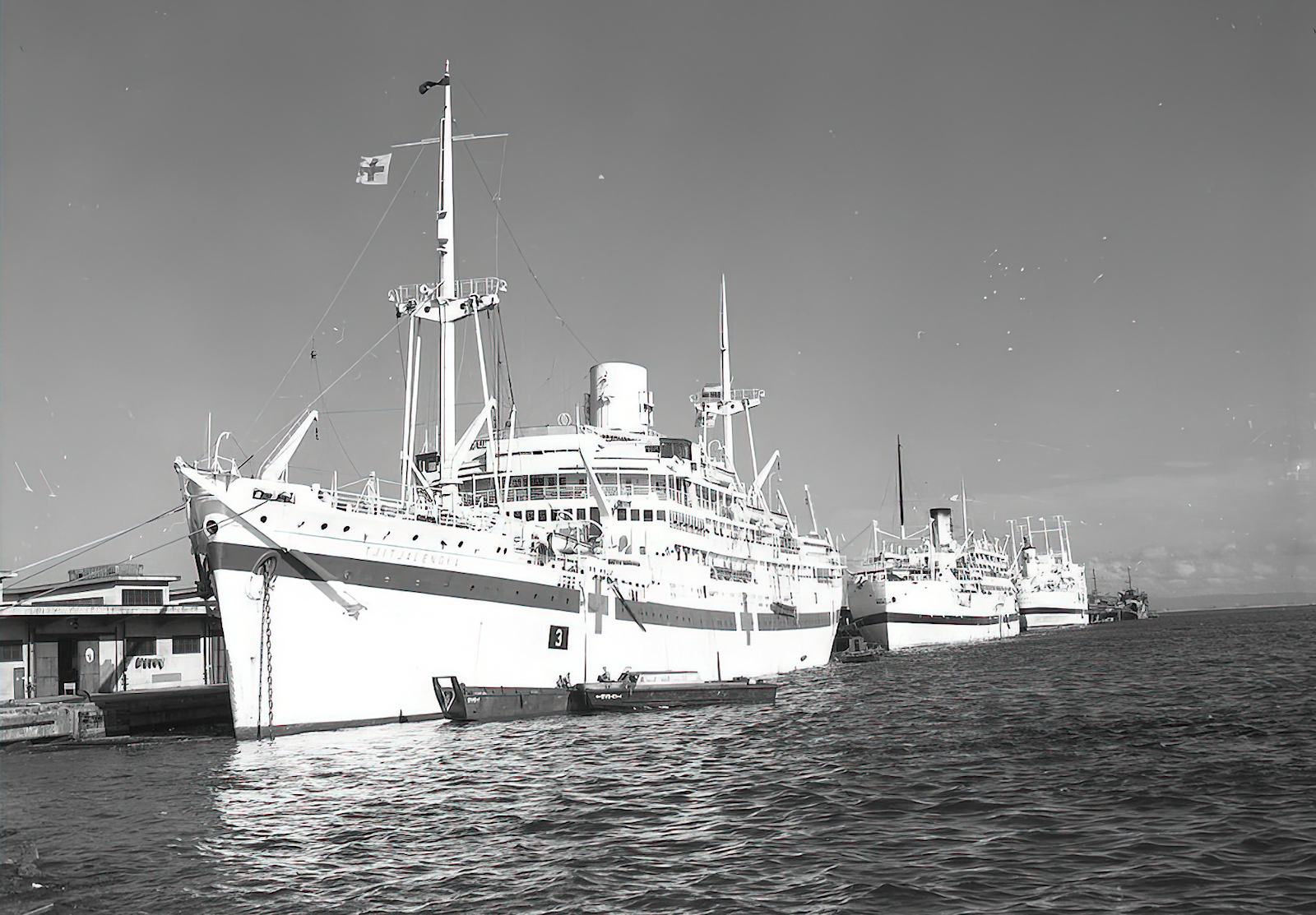
Three hospital ships docked at Yokohama: TJITJALENGKA (British), MARIGOLD (U.S. Army), and BENEVOLENCE (U.S. Navy). Part of the effort processing prisoners of war held by the Japanese. Image National Museum of Health and Medicine MAMAS D45-456-3-9
Liberated British and Commonwealth personnel fit to fly out were taken to an air strip near Tokyo for passage to Manila, those who could go by sea were ferried out to ships in Tokyo bay; those requiring medical treatment were embarked in TJITJALENGKA. Amongst those liberated were civilian internees including women and children, these were transferred to the escort carriers RULER and SPEAKER which had been cleared of aircraft and hastily converted to accept them. At 13:00 on September 3rd SPEAKER was the first allied ship to depart from Tokyo Bay bound for Manila with 477 liberated allied personnel. All the men that TJITJALENGKA received needed medical care, many were extremely thin and malnourished, suffering from vitamin deficiencies; some required surgical care as a result of their brutal treatment in the camps. By the time TJITJALENGKA was ready to sail on September 16th at least 14,000 ex POWs had passed through the reception Centre; another British Hospital Ship, the HMHS VASNA had arrived on the 14th to continue the task.
On departing from Tokyo Bay in company with the destroyer TROUGBRIDGE she was carrying a full complement of liberated British and commonalty P.O.W.s including 459 New Zealanders and 46 Australians. As she steamed into the bay and passed by the allied ships at anchor the British ships companies were on deck cheering, and ships sounded their sounding hooters, the American ships companies were all at attention and saluting. On TJITJALENGKA all ex P.O.W.s who could get on deck were there cheering, and waving along with the Dutch officers, the Chinese and Indonesian crew and the British Medical and Nursing staff that could be spared. She was to sail for Manus on passage to Auckland where she arrived on October 3rd to deliver the first batch of New Zealand former POWs to a rapturous reception at the quayside. She sailed for Wellington on the 5th, arriving there to a similar welcome on the 7th. She stayed only one night in Wellington sailing on the 8th and arrived at Sydney on October 12th. After discharging her Australian patients TJITJALENGKA was taken in hand by a Sydney dockyard for repair work to be carried out.
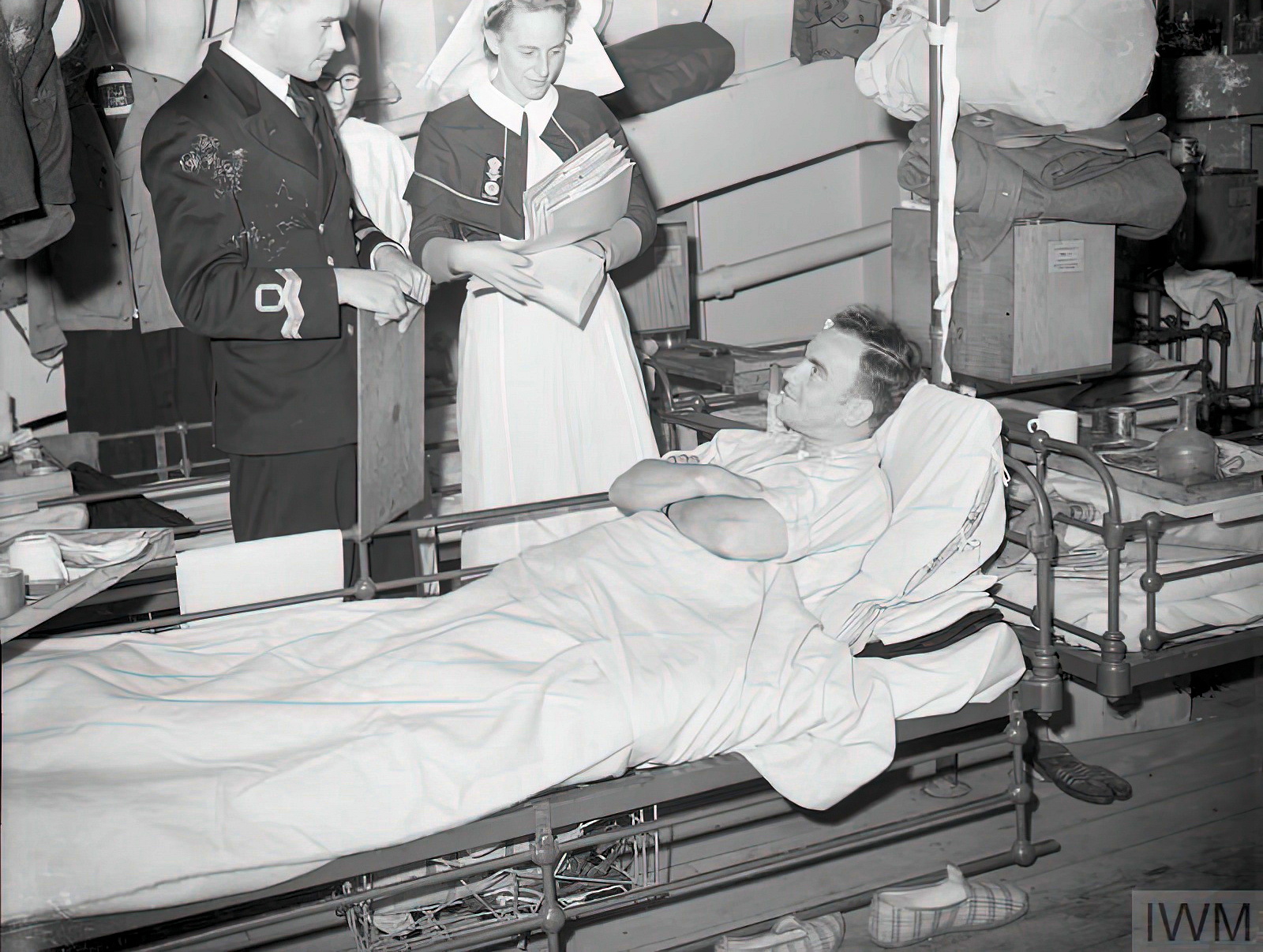
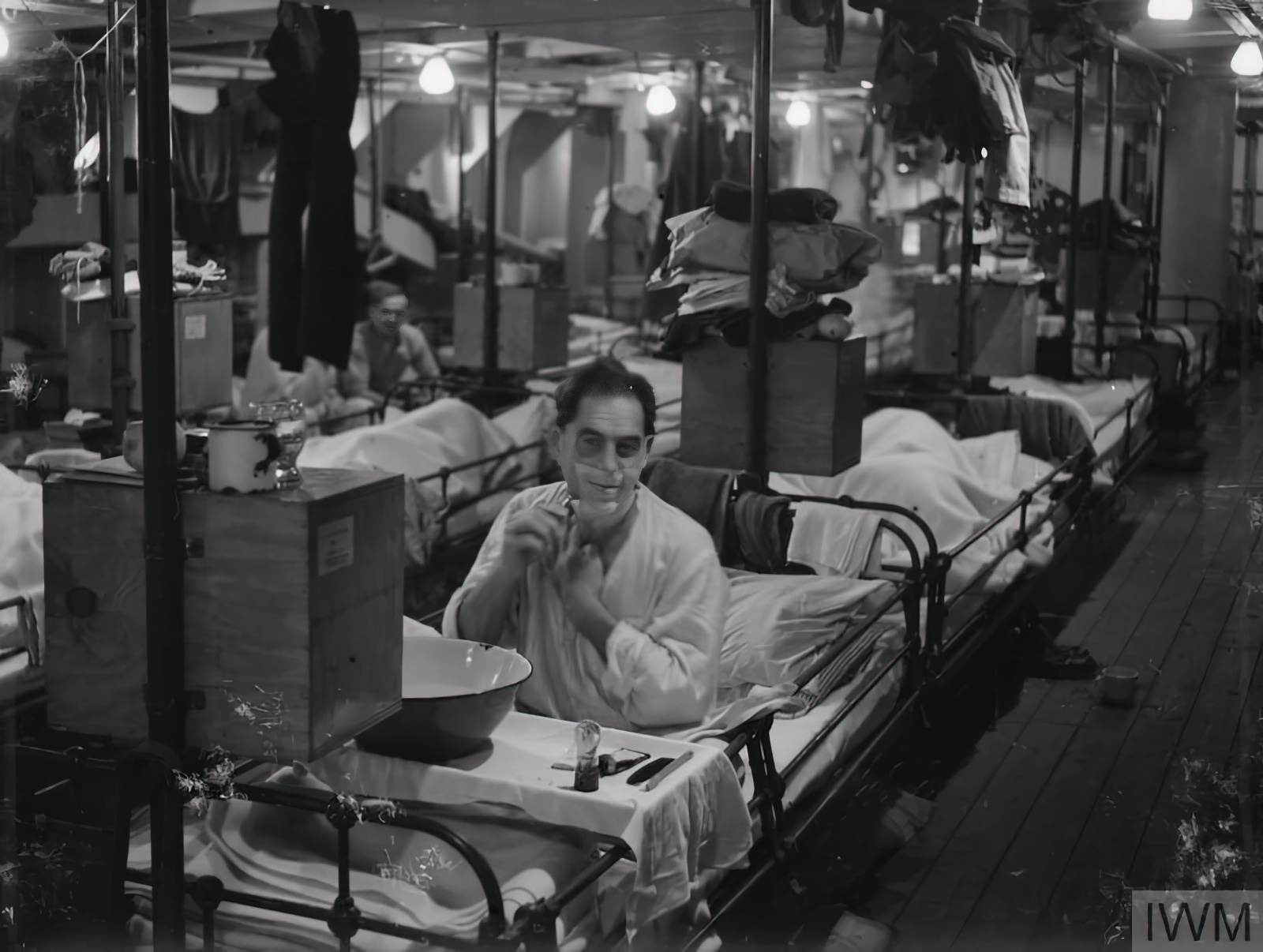
October 1945 above left: Surgeon Lieutenant Cutts, RNVR has a word with Able Seaman Reg Rampling during his morning visit to the ward. Oct 45 © IWM A 30938, Above right, enjoying the luxury of an early morning shave in bed is Signaller Charles Birse, Australian Army. Captured at Singapore, he spent 31/2 years as a Japanese Prisoner of War. IWM A 30935.
Below left: Suffering from the effects of 31/2 years in a Japanese prison camp, Jack Kirby, Australian Army, has his pulse taken by RN Sick Berth Attendant, Arthur Belfield. © IWM A 30936, below right: Left to right - Naval ratings J. Barnes from HMS KING GEORGE V and F. R. Booth from HMS FORMIDABLE; breakfasting with ex-Australian Army POW L. J. Keough on board the TJITJALENGKA. Barnes and Booth were both transferred to the TJITJALENGKA because of ill health. © IWM A 30937


The long voyage home
On completion her repairs and storing ship TJITJALENGKA sailed from Sydney on November 6th 1945 to collect and deliver patients for repatriation from various ports with the UK as her final destination. Her first port of call was a fuelling stop at Manus on November 14th before arriving at Hong Kong on the 25th. She was in port for five days and the Chinese crewmen were given leave. She sailed for Shanghai November 30th where she was to embark some Portuguese Nuns and Diplomats for passage home to Madeira. Arriving there on December 4th. On December 6th she sailed for Singapore, arriving on the 13th. Her she embarked more ex-POWs for repatriation before sailing for Madras on the15th. After calling at Madras on December 20th she arrived at Colombo on Christmas Day 1945. After celebrating Christmas in Colombo TJITJALENGKA sailed for Durban on the 27th.
She spent New Year’s Day 1946 at sea in the Indian Ocean, arriving at Durban on January 7th. Four days later on the 11th she sailed for Simon’s Town where she called on the 14th and sailed the same day for Freetown. She called at Freetown on the 24th, just over three years since she arrived there on her first duty as a base hospital ship, and sailed same day for Madeira, Portugal.
She called at Madeira on January 30th to disembark passengers and sailed the same day for Liverpool where she arrived on February 4th. Once the last of her patients and passengers had left the ship she put to sea again on February 5th for Tilbury Docks, arriving there on the 7th. The naval personnel now left the ship to return to Chatham Barracks and work started on February 15th to remove the hospital ship fittings and equipment in readiness for her conversion back into Passenger/Cargo liner; this work was completed by March 4th.
The M.V. TJITJALENGA was released from Wartime service on March 6th and sailed for Amsterdam on this date, arriving there on March 8th.
Post war service
TJITJALENGA was now back in the hands of her owners she was refitted and re-entered service operating out of Java. She is recorded as lying at anchor in the Port of Tanjung Priok, Indonesia on March 11th 1948. In the spring of 1968 the TJITJALENGKA was sold for scrapping to Ming Hing & Co. in Hong Kong. She arrived on her last voyage to Hong Kong on May 11, 1968, where shipbreaking was completed on November 10, 1968.
Notes:
Last modified: 30 July 2023
Primary information sources
Additional sources:
BT 389/30/31 Ship's record card held by the UK National Archive
Woolman, J. (2001) ‘Hospital Ship: Memories of HMHS "Tjitjalengka" During World War II’, Redditch, Brewin Books
My part in WW2 (2005) Don Jude – reminiscence on WW2 People's War#
(1954) Surgeon Commander J. L. S. COULTER, D.S.C., R.N., ‘THE ROYAL NAVAL MEDICAL SERVICE’ London, Her Majesty's Stationery Office - Volume 1'Administraion'
Comments (0)